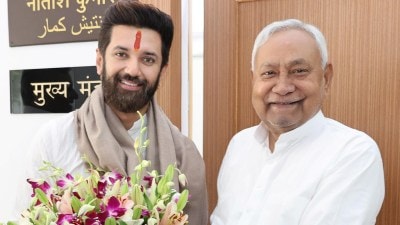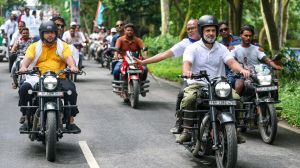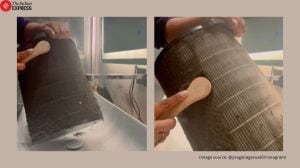Countdown to violence
Sudhakar Naik or Sushil Kumar Shinde, Chhagan Bhujbal or Babanrao Pachpute, 1993 or 2003 — the only difference is in names and dates. O...

Sudhakar Naik or Sushil Kumar Shinde, Chhagan Bhujbal or Babanrao Pachpute, 1993 or 2003 — the only difference is in names and dates. Otherwise, it’s the same old Congress culture of ‘‘leave-things-alone-till-they-explode’’. The BJP has started a systematic programme of maha-aartis in Mumbai as per its announcement immediately after the August 25 bomb blasts. These public ceremonies are achieving their declared aims: Organising Hindus against the ruling Congress-NCP government and against ‘‘terrorism’’ (read ‘‘Muslims’’). Maha-aartis are laying the ground for violence.
So is the Maharashtra government doing anything to prevent this threat to law and order? Has it banned maha-aartis? Has the police arrested any of the organisers under Section 153 A (promoting communal enmity)? Mumbai’s citizens know only too well what maha-aartis are all about. Barely had their city emerged from six days of the worst communal violence it had ever seen, in the wake of the demolition of the Babri Masjid, that the RSS decided the situation was ripe to start its campaign of ‘‘maha-aartis’’. These were aartis performed on the road outside (never inside) temples, accompanied by anti-Muslim speeches. They were ostensibly meant to pressurise the then Congress government into stopping Friday afternoon namaaz on the roads which allegedly blocked traffic, and stopping the calling out of azaan on loudspeakers. The RSS roped in the Shiv Sena for the campaign.
The first maha-aarti was held on December 26, 1992, at Kalachowkie, a Shiv Sena stronghold, where namaaz was never performed on the roads, because the existing mosques could easily accommodate the few Muslims in this Hindu-dominated area. Assistant Commissioner of Police K.L. Bishnoi told the Srikrishna Commission that the local senior inspector had apprised him about the political nature of the maha-aarti, but Bishnoi considered it ‘‘only indirect political activity’’. An anti-Muslim pamphlet was distributed by the Hindu Jan Jagran Abhiyan.
Within eight days, violence again broke out in Mumbai, but the maha-aartis went on in full swing because the police classified them as ‘‘religious functions’’, exempt from ban orders. The Srikrishna Commission was told that by January 7 1993, a Confidential Source Report had alerted the police about the possibility of ‘‘Shiv Sainiks returning from maha-aartis attacking Muslim properties’’. As the commission found out, even Muslim lives were lost as a direct result of this campaign led by heavyweights Ram Naik, Manohar Joshi, Kirit Somaiya, Pramod Navalkar.
Today, as Somaiya with Gopinath Munde, Uddhav Thackeray and Narayan Rane leads a political campaign, the government cannot even hide behind the fig leaf of ‘‘religious function’’ to explain its inactivity. The explanation is obvious. Can Shinde forget that the Shiv Sena chose not to oppose him in his crucial by-election to qualify as CM? Can Bhujbal forget his Sena roots?






- 01
- 02
- 03
- 04
- 05

























